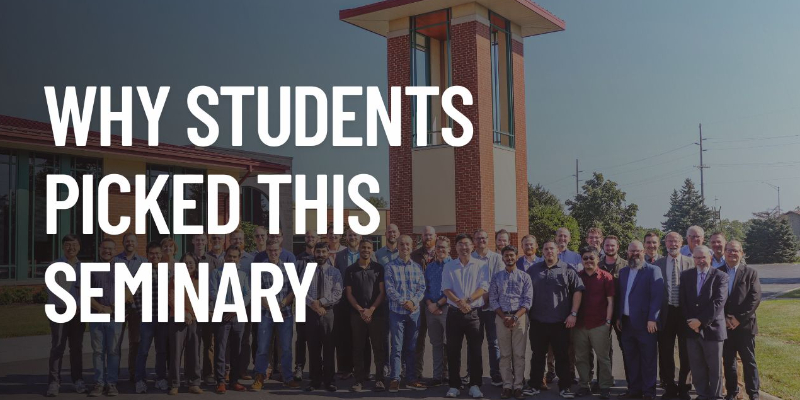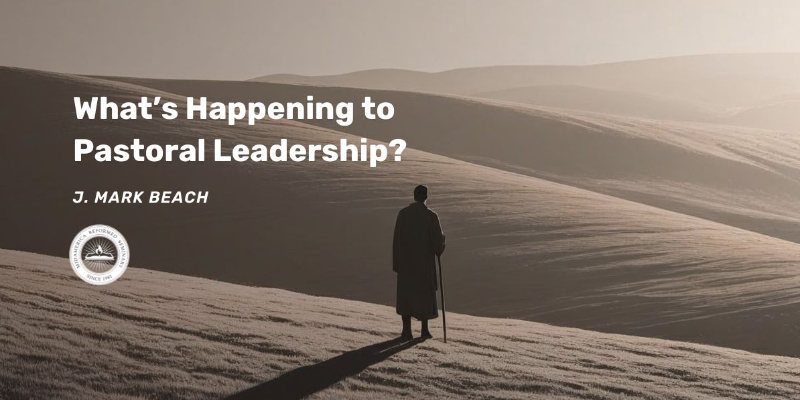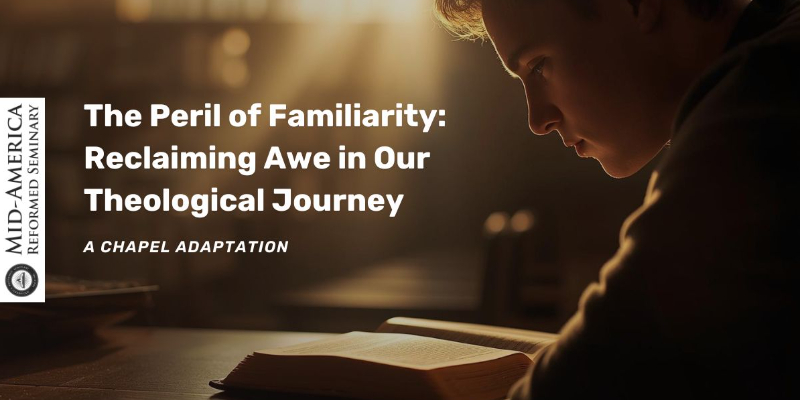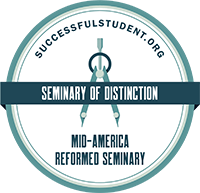
The Ministry of Presence: Understanding Pastoral Visitation in Hospitals and Nursing Homes
This article has been adapted from MARSCAST Episode 258
In the life of a congregation, few ministries are as quietly significant as pastoral visitation. When loved ones face hospitalization or transition to care facilities, the presence of a pastor extends Christ's shepherding care beyond the walls of a church. 2001 MARS graduate Rev. Harold Miller, who has served congregations in Iowa, Missouri, and Illinois over nearly two decades, offers valuable insights into the theological and practical importance of this ministry.
The Theological Foundation of Pastoral Visitation
According to Rev. Miller, pastoral visitation is far more than a mere courtesy call. At its heart, it represents the ministry of Christ to His people—bringing the comfort of the Shepherd through His Word to those who are vulnerable, isolated, or suffering.
Miller explains that when someone sits in the congregation Sunday after Sunday, they need to be convinced that their pastor genuinely loves them and their family. One practical way this love is demonstrated is through the extension of the pulpit ministry—when the pastor goes to the family member or congregant (and sometimes even to those outside church membership) to bring Christ's love, the fullness of the gospel, and biblical application to their particular situation.
Miller references an old term that sheds valuable light on this pastoral undertaking: poimenics. Derived from the Greek word for "shepherd," poimenics describes the regular work of the under-shepherd—the pastor. Understanding poimenics helps us see pastoral visitation not as an isolated duty but as part of the comprehensive character of pastoral ministry that applies Christ's shepherding care to His people.
Historical Development
Miller notes that the historical development of pastoral visitation offers important insights. While we have limited information about visitation practices immediately following the New Testament era, the Reformation period—through figures like Luther and Calvin—laid important groundwork. This foundation was further developed by men like Richard Baxter in his work "The Reformed Pastor" and John Owen's treatise "The Duty of Pastor and People Distinguished."
He particularly highlights the significant contributions of the Dutch tradition. As early as the Synod of Wesel in 1568, there were discussions and planning for pastors to care for their flocks beyond church walls. The mid-1800s work "Practical Theology" by Dutch professor J.J. Van Oosterzee offers valuable reference material for understanding pastoral visitation.
Types of Pastoral Visitation
Miller helpfully categorizes pastoral visitation into two main types:
- Normal/Regular Visitation - Nursing homes and care facilities
- Emergency/Unique Visitation - Hospitals and crisis situations
This categorization becomes important when considering timing, circumstances, duration, and the nature of these visits.
Timing and Circumstances
The question of timing—when a pastor should visit and under what circumstances—varies between regular and emergency visitation, explains Miller.
For regular visits to nursing homes or care facilities, he advises pastors to visit during business hours, being mindful of the resident's personal schedule. If a member naps after lunch, it's best not to visit at 1:00 PM—even if that might be most convenient for the pastor. The nature of shepherding requires the pastor to adjust his schedule to meet the needs of those under his care.
Emergency visits, such as hospital visitation following an accident, demand immediate attention regardless of the hour. When a family calls at 9:30 PM about a loved one in serious condition, the pastor doesn't say, "I'll see you tomorrow at 11:00 AM." He gets up and goes because that's what the situation demands. This sacrificial response shows that the shepherd truly represents the Great Shepherd, which helps open ears to preaching and hearts to biblical counsel.
Miller shares a personal anecdote from his first pastoral charge in Iowa, where he was concerned about learning quickly when congregation members faced emergencies. He actually purchased a police scanner so he could hear when ambulances were dispatched to addresses he recognized from his church directory. There were occasions when he would arrive at a home before the ambulance crew, leading them to eventually comment, "You beat us here again!" This practical demonstration of care communicated Christ's love in tangible ways.
Beyond Traditional Settings
While nursing homes and hospitals represent the most common visitation settings, Rev. Miller explains that pastoral care sometimes extends to jails and prisons as well. During his ministry in Kansas City, his congregation received a man into church membership while he was in maximum security prison. Visiting him required significant preparation—security clearance arrangements, travel planning, and navigating prison protocols.
When entering the facility, Miller and the accompanying elder would pass through multiple security checkpoints, including one with a sobering sign warning: "Beyond this point, no rescue." This referred to the policy that in case of a riot or uprising, security personnel wouldn't immediately attempt rescues beyond that boundary.
Despite these challenges, seeing the joy on their member's face when his pastor and elder arrived made every effort worthwhile. Miller recalls how the prisoner was visibly moved that church leaders would come to minister to him inside the prison walls. As Miller often remarked to the accompanying elder, they received the greater blessing from these visits—witnessing the excitement and joy their presence brought to this brother in Christ was incredibly moving.
The Nature of Pastoral Visits
According to Rev. Miller, a successful pastoral visit actually begins long before the actual encounter—it starts with the pastor knowing his congregation in real, personal ways. This relationship-building, sometimes developed over months or years, provides crucial context when transitions or emergencies occur. The broader context of faithful preaching, teaching, and regular ministry gives the pastor an established relationship with individuals and families that enriches these special visitation moments.
He explains that the actual visit begins in the pastor's study with prayer for his people and preparation of appropriate Scripture passages. Before visiting someone newly admitted to a nursing home, the pastor should communicate with family members to understand specific circumstances that will help him apply God's Word more effectively.
This preparation is essential because pastors, like anyone else, can fall into treating visitation as merely another checkbox on their to-do list. Rev. Miller cautions that such an approach doesn't serve the ministry Christ intends for His people through pastoral care.
Hospital Visits (Emergency)
When a hospital visit is needed, Rev. Miller outlines how the process typically unfolds:
- Upon receiving notification, the pastor travels promptly to the hospital.
- After parking (hopefully in designated clergy parking), the pastor checks in at reception, providing the patient's name and room number.
- Before entering the room, the pastor consults with nursing staff to ensure it's an appropriate time to visit, being mindful of medical procedures and the patient's privacy.
- Upon entering, the pastor assesses what the person can receive—should this be a five-minute visit or thirty minutes? Most hospital visits don't exceed thirty minutes due to the patient's condition and medical needs.
- The pastor speaks with the patient if they can respond, reads an appropriate Scripture passage, and prays with or for them.
- After leaving, the pastor documents the visit for follow-up and reporting to church leadership.
Nursing Home Visits (Regular)
For nursing home visits, Rev. Miller describes a different approach:
- The pastor schedules visits at optimal times for the resident—avoiding mealtimes and respecting personal routines.
- These visits typically last about an hour—long enough for meaningful interaction but not so long as to become tiresome.
- Most pastors visit nursing home residents approximately once monthly, though more frequent visits may occur if circumstances warrant.
- The visit includes Scripture reading and discussion, inquiries about physical well-being (sleep, nutrition, medical concerns), and spiritual conditions (prayer life, reception of the Word).
- The pastor prays with the resident before departing and documents the visit afterward.
He emphasizes that these spiritual conversations are particularly important because nursing home residents don't typically have the regular spiritual fellowship that other members experience on the Lord's Day. While nursing homes may meet physical needs, they aren't always conducive to spiritual nurture. The pastor brings the light of the gospel and the love of the congregation into what can sometimes be spiritually isolating environments.
Communication with Family Members
Rev. Miller explains that families naturally want to know about their loved one's spiritual and emotional state, especially when they can't be present during pastoral visits. The pastor typically reports monthly to the church council or consistory about his visits, noting changes in physical condition, spiritual concerns, or even financial needs that might require deacons' attention.
This reporting ensures that spiritual leaders understand and address the needs of members who can't attend regular services. When family members approach the pastor with questions about their loved one, he can share appropriate information within privacy boundaries—particularly with spouses who have legal rights to such information.
This communication, according to Miller, reassures families that their loved ones are being cared for by their church community, which is a great blessing.
A Word to Future Pastors
Rev. Miller encourages those preparing for pastoral ministry to embrace the full scope of poimenics—applying their theological education, study, and devotion to those most vulnerable in their congregations. Visiting the hurting and lonely brings the gospel to them in tangible ways.
He notes that people in nursing homes often experience profound loneliness. A kind, friendly visit from their pastor, bringing the comfort of God's Word, means more than we can imagine. Similarly, being present with someone after an accident, injury, or difficult diagnosis brings Christ's hands and heart directly to their situation.
Rev. Miller acknowledges that this ministry will require sacrifice. Pastors must recognize that these visits "need to be done because they're good, and need to be done now because they're important." It may not always be convenient, but neither was Christ's sacrificial love for us, especially at the cross. Something of that sacrificial spirit must inform our understanding of pastoral visitation.
In the end, Rev. Miller sees faithful pastoral visitation as more than duty—it's an expression of Christ's ongoing shepherd ministry to His people through His under-shepherds. When pastors serve in this way, they not only bring blessing to the visited; they themselves are blessed by participating in this tender work of the Kingdom.
Recent articles




